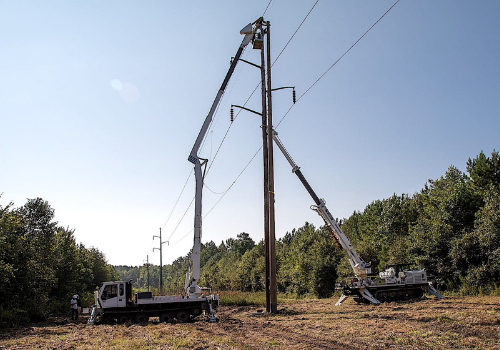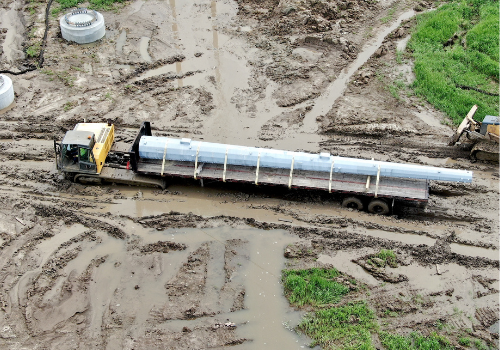Utility work can involve some of the most remote, severe terrain imaginable. Power lines and pipelines may cross streams, rivers, ponds, wetlands, hills or mountains. No matter what the surroundings, utility contractors need to be able to get equipment, crews and materials to and from the site — in any season.
For demanding, hard-to-access utility applications, the extreme mobility and versatility of crawler carriers makes them ideally suited to the job.
Go where other equipment can’t
The two main advantages crawler carriers offer over wheeled vehicles are better traction and lower ground pressure. Tracked carriers are purpose-built to deal with steep inclines, loose soil and wet environments on utility rights-of-way.
“A tracked carrier can get you in and out of places you can’t go with a wheeled truck,” says Marie-Élaine Dion, marketing manager at Prinoth. “The weight distribution and low ground pressure of these machines — as low as 4.99 psi fully loaded — means they’ll power right through sand, mud, even swamps. Our Panther series utility carriers can ford water up to 51 inches deep. We make them to go wherever you need to go.”
“Much of the work electrical utilities do goes along with bad weather,” says David Byrd, marketing manager at Morooka. “When a storm drops 22 inches of rain and knocks out the power, a truck isn’t an option anymore. Crawler carriers allow crews to get there and bring everything back online as quickly as possible. Being able to work in any conditions also allows utilities to extend their season a bit.”
“The most important part of utility installation, maintenance and repair work is getting to the jobsite and back safely,” says Jesse Whittaker, sales director for Terramac. “You’re simply not going to drive through a swamp or climb a 30-degree incline with a typical rubber-tired vehicle where the risk of getting stuck is so high. Terrain challenges become less of a concern with tracked carriers because they’re proven to reduced slippage.”
 Designed for the task at hand
Designed for the task at hand
In addition to their all-terrain capability, crawler carriers offer the versatility to take on a wide range of utility applications.
“Anything you can mount on a truck, you can mount on a Morooka crawler carrier,” says Byrd. “Morooka offers a full line of utility-specific models, with payload capacity from 10,000 to 46,000 pounds. We work directly with the OEM utility industry to design machines they can use out of the box. For instance, we moved the engine mount to give them more room to lay down their booms. And in some cases, we’ll shorten or lengthen a frame based on the customer’s needs.”
“Crawler carriers are true Swiss Army knife machines,” says Whittaker. “At Terramac, we make it effortless to change out beds and attachments. So the machines are extremely versatile. Throughout a pipeline project, a single crawler carrier may do multiple jobs: haul out timber and stumps with a dump bed during land clearing, carry crane mats to and from the site with a flatbed, pull a fifth wheel trailer to deliver a power pole to the jobsite or carry a hydroseeding unit for final reclamation.”
“Working with leading crane and aerial OEMs, Prinoth was the first to build tracked vehicles specifically for the utility sector,” says Dion. “Panther series carriers feature a C-channel frame, the same as a standard truck chassis. This provides an ideal platform for any utility attachment, which can easily be powered through the auxiliary pump drive. The carrier and implement are perfectly integrated.”
“In the end, the goal is to match the attachment with the capabilities of the carrier,” says Byrd. “The attachment is what’s really going to do the work. We just get them there.”
 Productivity you can count on
Productivity you can count on
From installing a new pipeline to maintaining a transmission right-of-way, uptime and productivity are all-important. That makes equipment reliability, service and support critical — especially when you’re working in remote locations.
“Customers want to know they have a safe, reliable machine that won’t leave them hanging,” says Dion. “We’re continually testing and improving our machines. We subject our carriers to operating conditions far tougher than anything they’ll ever face on the jobsite. So you won’t have to wonder whether you’re going to be able to finish the project.”
“We recognize contractors are looking to reduce operating costs,” says Whittaker. “We make Terramac crawler carriers as reliable and cost-effective as possible — from product development to our expansive dealer network spanning the U.S. and Canada with trained service technicians and parts availability. Our focus is on keeping contractors up and running.”
“Good service starts with trained, knowledgeable people who can quickly solve problems in the field when needed,” says Byrd. “We offer comprehensive, in-person training with our service team at the OEM or dealer location. Customers expect nothing less.”
“If there’s an issue, we stand behind customers with dedicated technical support and spare parts hubs across North America,” says Dion. “Contractors can get the replacement part they need, install it, and be back on the job in no time. Our job doesn’t end once we sell a crawler carrier. Support is something we take very seriously.”
What’s ahead for crawler carriers
As the utility market changes, OEMs and contractors will continue finding new ways crawler carries can help improve productivity and safety.
“The demand for crawler carriers in the utility market will continue to grow as more contractors understand the versatility these machines offer,” says Whittaker. “The ability to use multiple attachments and build custom configurations to fit their needs is priceless.”
“Bigger is better when it comes to the utility world,” says Byrd. “OEMs are constantly trying to figure out how to go higher safely. They’re looking to put longer-reach attachments on smaller and smaller carriers. As an added safety measure, we’ve also introduced a remote control option. Couple that with an OEM’s remote and you can control the entire machine, carrier and attachment, from up to 500 feet away.”
“More new applications are being developed all the time,” says Dion. “If utility contractors could use a crawler carrier to transport crews and materials to the jobsite instead of building a road, that saves time and money. They could use this tool to do something in a totally different way.”
Brands Featured in the Article:
Join thousands of industry peers who receive utility construction industry news and trends each week. Subscribe to The Utility Expo Newsletter.












